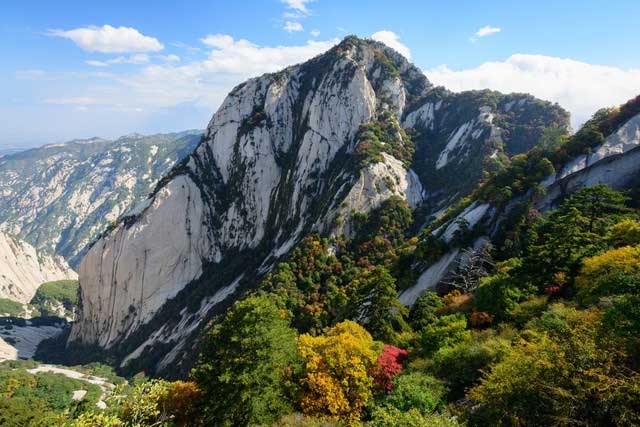The Chinese have long held this land in high regard.
Revered as the “Dragon Vein” of China, the Qilian Mountains occupy a unique position in the history and culture of China. There are 751 named peaks in the range, with the highest being Mount Taibai at 3,767 meters.
As one of the oldest mountain ranges in China, the Qilian Mountains have a history spanning over 200 million years. This mountain range runs east-west, stretching over 1,600 kilometers across central China, passing through the provinces of Gansu, Shaanxi, Henan, and Anhui.


The Qilian Mountains separate the humid subtropical climate in the south from the dry temperate climate in the north. (Illustrative image).
The western end of the Qilian Mountains lies in the mountainous region of China, bordered by the Kunlun Mountains to the west and the Qilian Mountain range to the northwest. The eastern end meets the flat lands where the Huaihe River extends from the mountains to the sea.
The Qilian Mountains and the Huaihe River form the “Qin-Huai Line”, which has long been regarded as a natural boundary between northern and southern China. The “Qin-Huai Line” serves as a barrier shielding the south from the cold winds of the north and prevents the humid air from the south from infiltrating the north.
The Qilian Mountains separate the humid subtropical climate in the south from the dry temperate climate in the north. They also create a watershed between China’s two largest rivers – the Yellow River in the north and the Yangtze River in the south.
Why did the ancients choose the Qilian Mountains as the resting place for emperors?
For thousands of years, the Qilian Mountains have been regarded as a geological treasure trove by ancient Chinese. Emperors from the Qin, Han, Tang dynasties, and other dynasties were buried around the Qilian Mountains after their passing, along with countless princes, nobles, and dignitaries who also rest in this “dragon vein” land.
Since ancient times, there has been a saying “Eight hundred peaks of the Qilian Mountains, One hundred thousand ancient tombs” to describe the vast number of ancient tombs in the Qilian Mountains. (The figure of eight hundred peaks is a relative number used by the ancient Chinese compared to the actual 751 peaks in the Qilian range).
From the ancient perspective of Yin-Yang and the Five Elements, the Qilian Mountains are a very famous “Dragon Vein.”

In this context, the varying shapes of the peaks of the Qilian Mountains are viewed as “dragon ribs”, the rocks as “dragon bones”, the soil as “the flesh and blood of the dragon”, and the vegetation as “dragon hair.”
Before burying the deceased, the ancients often “searched for dragons” – a method of finding the ancestral bloodline’s vital location, primarily involving “searching for dragons, observing auspicious signs, examining water sources, tapping the grave, and determining direction.”
Among all the “dragon veins” in China, while the Kunlun Mountains are viewed as the origin of the “dragon vein” in Chinese civilization, the Qilian Mountains are considered the “dragon vein” of utmost importance in the ancient Chinese worldview.
This is why the ancients held the Qilian Mountains in such high esteem. According to ancient Chinese beliefs, choosing ancestral burial sites in this mountain range can benefit descendants for generations to come.
Spiritual Land of China
Today, in the Qilian Mountains, many can admire the tombs of emperors from the Qin, Han, and Tang dynasties.
There are two important cities near the Qilian Mountains that preserve many ancient cultural values of China: Xian and Luoyang.
Xian (in Shaanxi), formerly known as Chang’an, is home to the ruins of a prehistoric city over 6,000 years old – the oldest city found in China.

Xian/Chang’an is one of the ‘Four Great Ancient Capitals’ of China.
As the capital of 13 Chinese dynasties, including the powerful Han and Tang dynasties, Xian/Chang’an is one of the “Four Great Ancient Capitals” of China. It was also the first city in the world to have a population of one million around 750 AD.
Being the eastern starting point of the ancient Silk Road, Xian is an international trade center and a cultural exchange hub. It is also a major religious center for Taoism, Buddhism, and Islam.
In 1974, farmers digging a well near Xian discovered the colossal tomb of Emperor Qin Shi Huang, which contained an army of over 8,000 life-sized terracotta warriors.
About 380 kilometers east of Xian lies Luoyang – another ancient capital that rivals Xian in historical significance. Luoyang has a long-standing cultural tradition, especially in Confucianism.
The “Gene Bank” of Wild Biodiversity
In addition to its ancient cultural value, the Qilian Mountains boast stunning natural scenery, particularly the Zhongnan Mountain and Mount Taibai.
The scenery of Zhongnan Mountain is breathtaking. As the main peak of the Qilian range, it has historically been home to many Daoist hermits since the Qin dynasty, along with Buddhist monks… and even today, many people choose to live here.

The Qilian Mountains also feature beautiful natural scenery.
Another noteworthy aspect is that the Qilian Mountains are a region rich in wild flora and fauna – a “wild treasure” of this country. Primarily extending across Shaanxi province in northwest China, the Qilian Mountains cover an area of over 50,000 km2 and are referred to as the “Wild Biodiversity Gene Bank” of China due to their vast array of wild plants and animals, Xinhua reports.
Data from the local forestry agency indicate that the Qilian Mountains are home to approximately 3,800 species of seed plants and 587 species of wildlife, including antelope, golden monkeys, giant pandas…
When giant pandas are mentioned, many immediately think of Sichuan; however, in reality, Shaanxi is the region with the largest population of wild giant pandas.
The giant pandas in Shaanxi reside in the main areas of the Qilian Mountains. Currently, the Qilian Wild Park is a very popular zoo in China.


















































